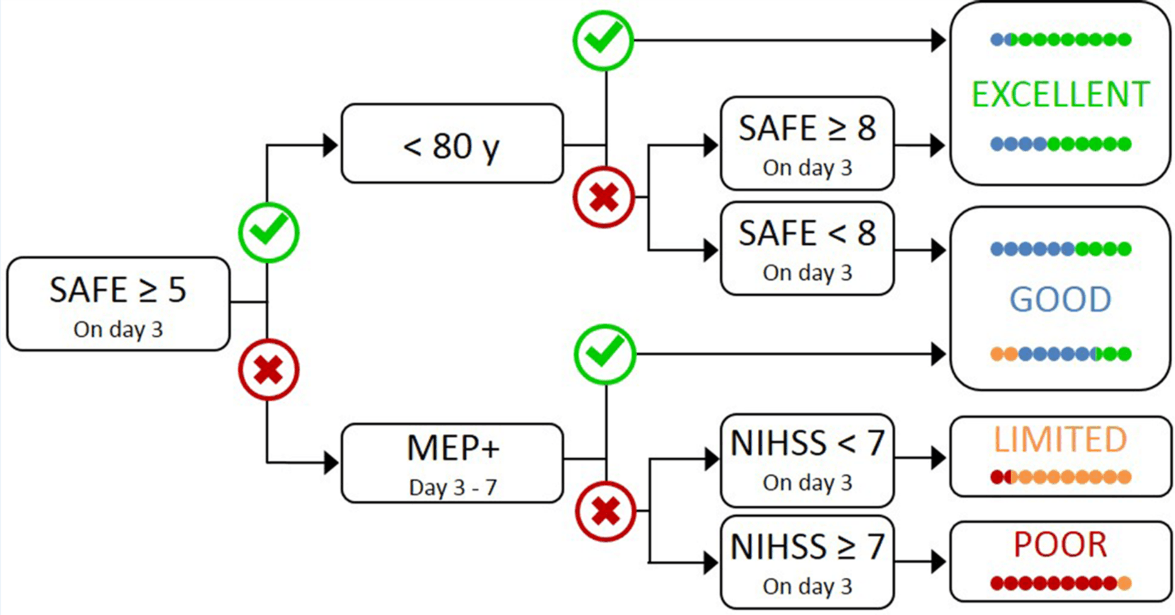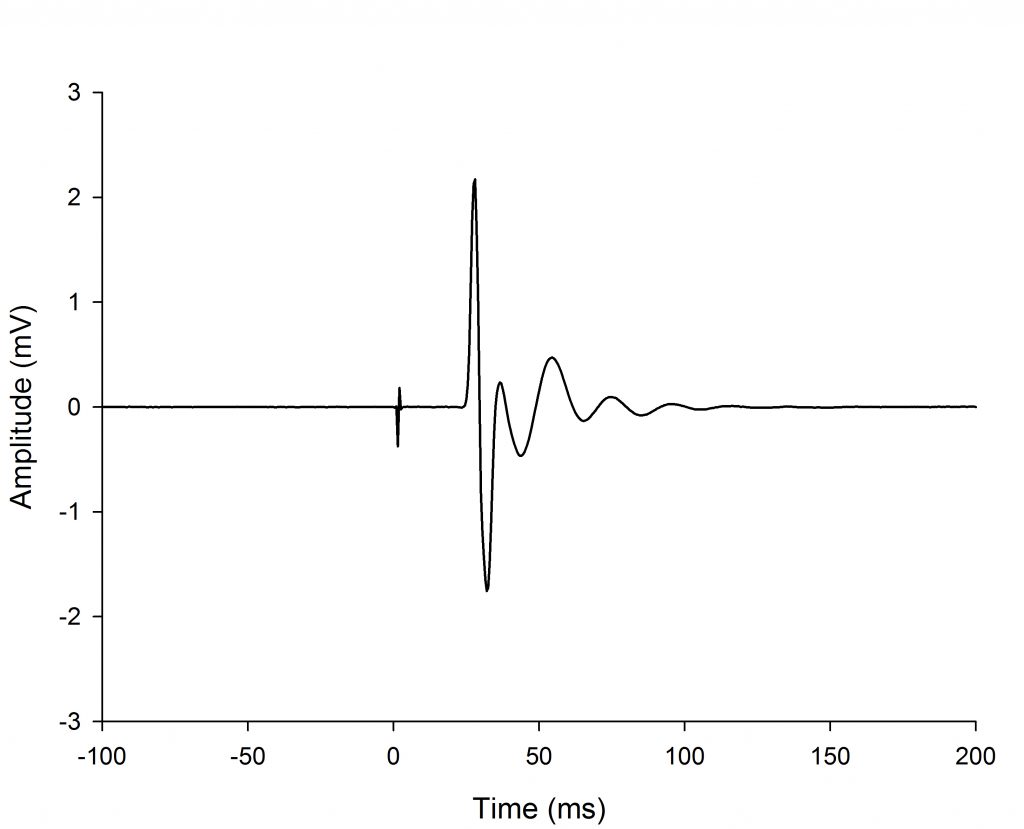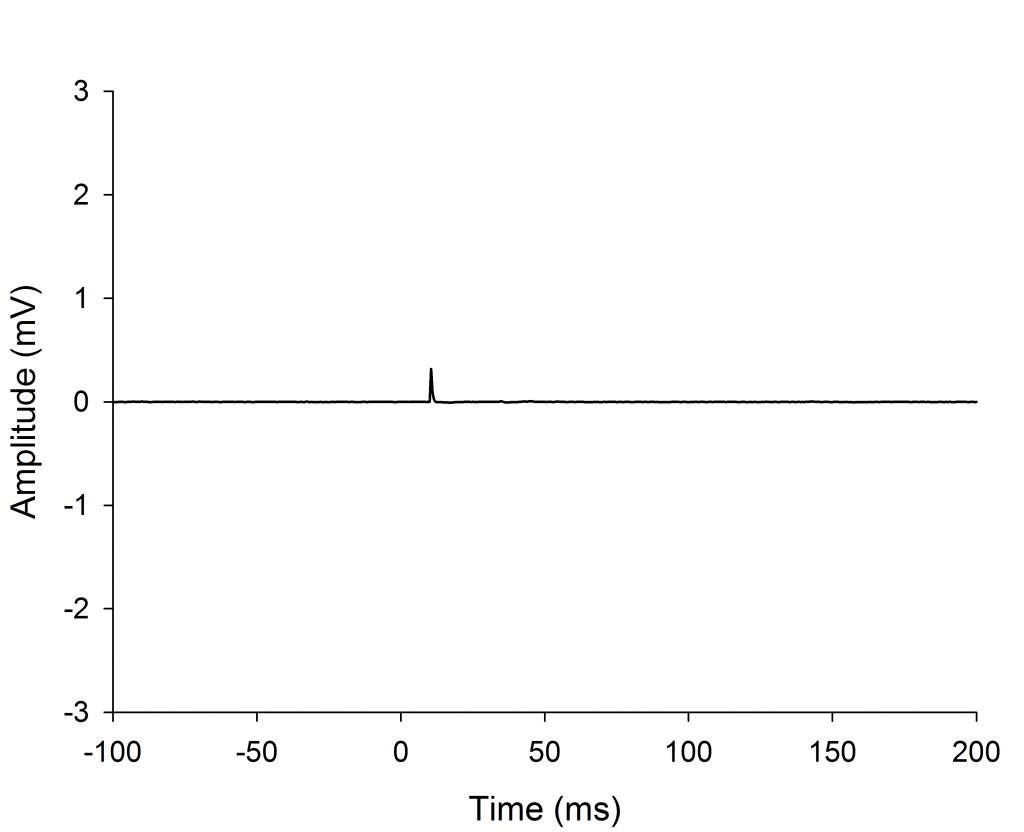Below are a few case examples of how the PREP2 prediction tool can be used to predict the upper limb functional outcomes for individual patients.
Case Example 1: Mrs A
Mrs A (78 y) was admitted to hospital on Friday afternoon with weakness and clumsiness of her right hand as a result of stroke.
The therapist saw her on Monday (Day 3). PREP2 was started by obtaining a SAFE score. Mrs A scored 4/5 for each of shoulder abduction and finger extension (movement through full range against gravity and resistance, but is weaker than normal). A SAFE score of 8/10 was documented. Mrs A was therefore predicted to have Excellent outcome as she had a SAFE score greater than 5 and was less than 80 years old.
Mrs A and her clinical team were given verbal and written information that she would most likely have an Excellent functional outcome for her upper limb. She was prescribed a home exercise programme and discharged later that day. She spent about 40 minutes doing practice with the right hand and arm each day for nearly three weeks.
At 12 weeks after stroke, Mrs A was using her right hand and arm ‘as normal’ for nearly all tasks. This was reflected in assessments of her right arm function (Action Research Arm Test score 56/57) and impairment level (Fugl-Meyer Upper Extremity Scale score 61/66). At 6 months after the stroke, she reported that she used her right hand and arm for nearly all the activities that she had previously used it for, and the quality of use was nearly the same as before the stroke (Motor Activity Log score 94%). Mrs A achieved the predicted Excellent functional outcome for her upper limb.
Case Example 2: Mr B
Mr B (83 y) was admitted to the hospital with a stroke. He couldn’t move his left hand and arm.
PREP2 was started. On day 1 he had a SAFE score of 0/10 (no palpable muscle activity in left shoulder abduction or finger extension). On day 2 his SAFE score was 2/10 (he had palpable muscle activity in both shoulder abduction and finger extension, but no movement, giving him scores of 1/5 for each). On day 3 he had a SAFE score of 5/10, as he had full movement against gravity but not resistance in shoulder abduction (3/5) and some movement with gravity eliminated in finger extension (2/5). Mr B was predicted to have a Good outcome as he was more than 80 years old and had a SAFE score greater than 5, but less than 8.
Mr B and his rehabilitation team were given verbal and written information that Mr B would most likely have a Good functional outcome for his upper limb, and be using his hand and arm in most day to day activities within 12 weeks. Although there was some weakness, motor pathways to the arm and hand were functionally intact.
To reach his potential, hand and arm rehabilitation focused on improving function by increasing strength, coordination and fine control. Mr B was advised he should use his affected hand and arm for safe daily activities and try to minimise compensation with the stronger arm and hand.
Mr B spent three weeks in inpatient rehabilitation.
At 12 weeks after the stroke Mr B was using his left hand and arm for many day to day activities. This was reflected in assessments of his left arm function (Action Research Arm Test score 47/57) and impairment level (Fugl-Meyer Upper Limb Scale score 57/66). At 6 months, he reported that he used his left arm for more than half the activities he was using it for before the stroke, but it was more slow and effortful than before the stroke (Motor Activity Log score 71%). Mr B achieved the predicted Good functional outcome for his upper limb.
Case Example 3: Mr C
Mr C (81 y) was admitted to the hospital with a stroke that produced weakness of his right hand and arm.
PREP2 was started. On day 3 after stroke, the physiotherapist scored his right shoulder abduction and finger extension movements as 0 and 2, and calculated a SAFE score of 2/10. In other words, Mr C had no movement at his shoulder and a small amount of extension in his fingers (but not full range). The physiotherapist also obtained Mr C’s NIHSS score on day 3 and scheduled a TMS assessment.
The TMS assessment took place on day 6 after the stroke. Responses were detected in the wrist extensor muscles of the affected arm (presence of motor evoked potentials, i.e. MEP+). These responses indicated that the stroke-affected side of the brain was able to send a message via motor pathways to the stroke-affected arm. This is good news, since the presence of these responses is usually related to a better outcome. Despite having a SAFE score below 5, the presence of MEPs meant Mr C was predicted to have a Good outcome.
Mr C and his rehabilitation team were given verbal and written information that Mr C would most likely have a Good functional outcome for his upper limb, and be using his hand and arm in most day to day activities within 12 weeks.
To reach his potential, hand and arm rehabilitation focused on improving function by increasing strength, coordination and fine control. AS movement returned, Mr C was advised he should use his affected hand and arm for safe daily activities and try to minimise compensation with the stronger hand.
Mr C spent six weeks in inpatient rehabilitation.
At 12 weeks after the stroke Mr C was using his right hand and arm (dominant) for quite a few tasks. This was reflected in assessments of his right arm function (Action Research Arm Test score 37/57) and impairment level (Fugl-Meyer Upper Limb Scale score 44/66).
At 6 months, he reported that he used his right hand and arm for many daily activities, but overall it was slightly slower or more effortful than before the stroke (Motor Activity Log score 67%). Mr C achieved the predicted Good functional outcome for his upper limb.
Case Example 4: Mrs D
Mrs D (74 y) came to the hospital after a stroke, she was unable to move her left hand or arm at all.
PREP2 was started. On day 3 after stroke the occupational therapist recorded a SAFE score of 0/10. There was no palpable muscle activity in the left shoulder abductors or left finger extensors. The therapist obtained the NIHSS score and scheduled a TMS assessment.
Mrs D had the TMS assessment on day 7 after stroke. Responses weren’t able to be detected in the muscles of the affected upper limb, there were no MEPs at the forearm (ECR) or hand (FDI). So at that time the motor pathways from the stroke-affected side of the brain to the left forearm and hand were not functioning.
Mrs D had an NIHSS score of 5 on day 3 after stroke. This means that Mrs D was predicted to have a Limited outcome for her upper limb, because although she had a SAFE score below 5 and was MEP-, her NIHSS score was less than 7.
Mrs D and her rehabilitation team were given verbal and written information that she had may regain some movement, possibly some hand opening and closing, though fine finger control was likely to remain challenging. She was likely to need to use her other hand to help with some activities.
To reach her potential, hand and arm rehabilitation focused on improving strength, active range of motion, and joint flexibility, and adapting daily activities to incorporate both upper limbs when necessary to achieve a task.
Mrs D spent eight weeks in inpatient rehabilitation.
At 12 weeks after the stroke Mrs D was using her left hand and arm for lifting some larger items, sometimes using the right hand to assist. She had difficulty with completing fine tasks as her dexterity was limited. This was reflected in assessments of her left arm function (Action Research Arm Test score 26/57) and impairment level (Fugl-Meyer Upper Limb Scale score 42/66).
At 6 months, Mrs D reported that she used her left hand and arm for some daily activities that she had used it for before the stroke, but those activities took longer and required more effort than before the stroke (Motor Activity Log score 57%). Mrs D achieved the predicted Limited upper limb functional outcome.
Case Example 5: Miss E
Miss E (58 y) came to the hospital after a stroke, she was unable to move her right upper limb or walk.
PREP2 was started. On day 3 after stroke the physiotherapist recorded a SAFE score of 0/10. There was no palpable muscle activity of the muscles responsible for right shoulder abduction or finger extension. The therapist obtained the NIHSS score and scheduled a TMS assessment.
Miss E had the TMS assessment on day 6 after stroke. Responses weren’t able to be detected in the muscles of the affected upper limb, there were no MEPs at the forearm (ECR) or hand (FDI). So at that time the motor pathways from the stroke-affected side of the brain to the right forearm and hand were not functioning.
Miss E had an NIHSS score of 11 on day 3 after stroke. Because of this, Mrs E was predicted to have a Poor upper limb outcome, as she was MEP- and her NIHSS score was greater than 7.
Miss E and her rehabilitation team were given verbal and written information that Miss E may regain some movement, and might be able to use her weaker hand to stabilise objects, but was unlikely to recover fine finger control. Upper limb rehabilitation focused on preventing secondary complications such as pain, spasticity, and shoulder instability, and reducing disability by helping her learn to compensate with her other upper limb for activities of daily living.
Miss E spent nine weeks in inpatient rehabilitation.
At 12 weeks after the stroke Miss E had not had any return of movement that could be used to assist with performing daily activities. However, she was able to wash and dress herself, and make her bed and a simple meal with her left hand and some adaptive equipment. She could apply her own sling to support the arm (helping to prevent shoulder pain) when she was up and about. The level of right upper limb recovery was reflected in assessments of arm function (Action Research Arm Test score 3/57) and impairment level (Fugl-Meyer Upper Limb Scale score 15/66).
At 6 months, she reported she was using the left hand instead of the right hand for most activities now, but that she didn’t have any pain and had good flexibility in the right hand and arm which helped with getting dressed (Motor Activity Log score 8%). She was able to walk by herself, but needed a stick to steady herself when outdoors. Miss E achieved the predicted Poor upper limb functional outcome.





